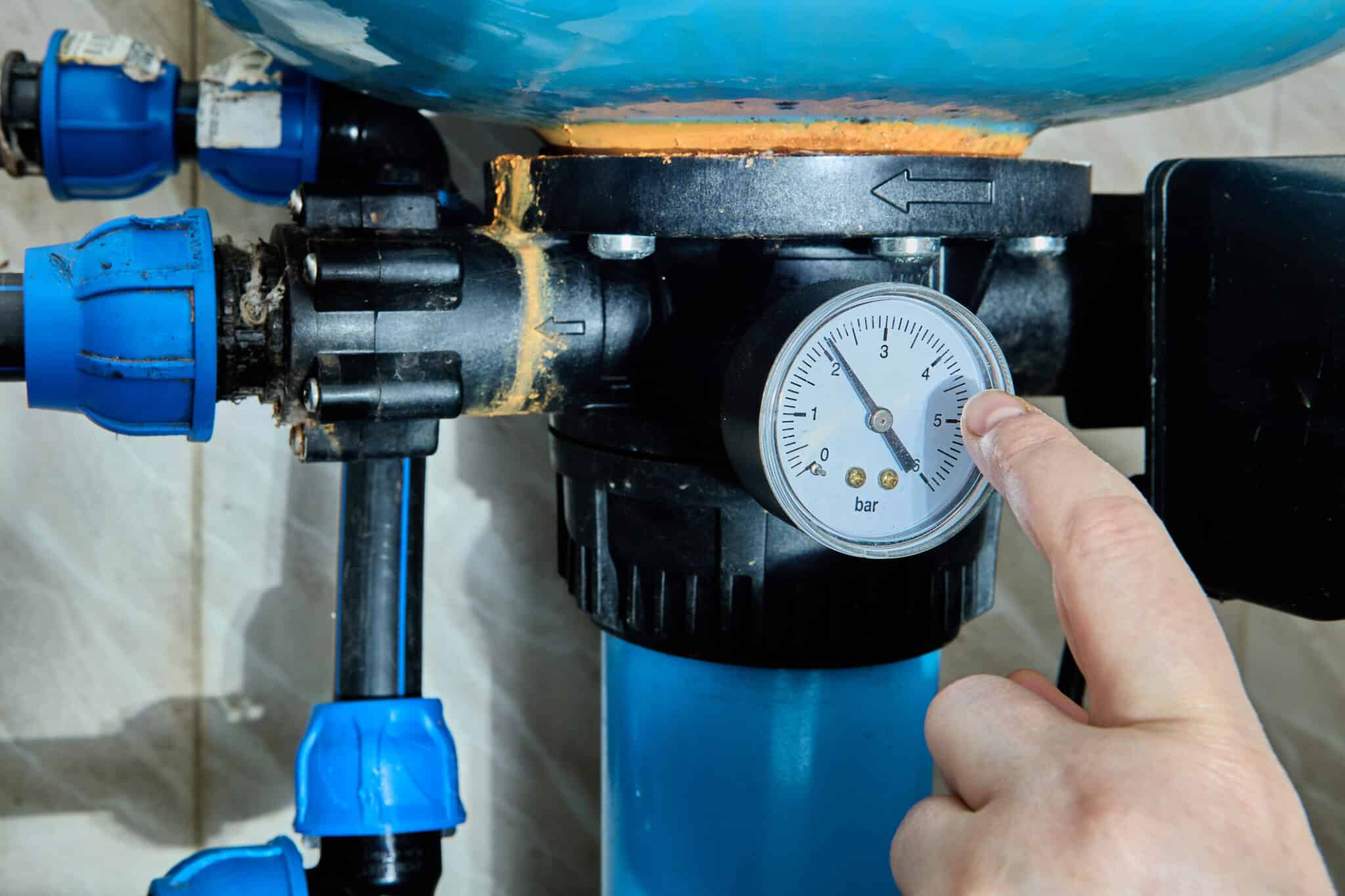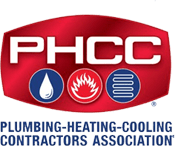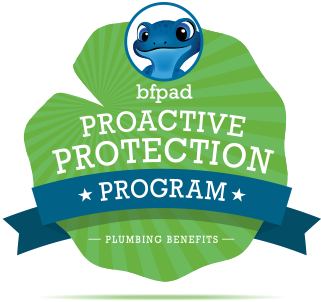
Reduce Water Pressure Issues
Water pressure plays a crucial role in your plumbing system’s overall performance. Both high and low pressure can lead to significant issues, such as leaks, damaged pipes, and disruptions to daily routines. Keeping your water pressure within an optimal range is essential for maintaining a healthy and efficient plumbing system, ensuring that everything runs smoothly without unexpected breakdowns.
Understanding Water Pressure: What You Need to Know
Water pressure is the force that moves water through your home’s plumbing system, typically measured in pounds per square inch (PSI). Maintaining the right water pressure—usually between 40 and 60 PSI—is essential for ensuring your fixtures and appliances function correctly. When water pressure is too high, it can strain pipes, cause leaks, and damage fixtures. Conversely, low pressure can lead to weak water flow, making daily tasks like showering or washing dishes frustrating and time-consuming.
Several factors can influence the pressure in your home, including the municipal water supply, the condition of your pipes, and the settings of your pressure regulator. In Saint Hedwig, as in many other areas, pressure can fluctuate due to seasonal changes or local construction work affecting the water mains. Understanding these factors helps you identify potential issues before they escalate into costly repairs.
A sudden change in water pressure often signals a problem within your plumbing system. It could be due to a faulty pressure regulator, a hidden leak, or a buildup within the pipes that restricts flow. Regularly checking your water pressure with a gauge and scheduling routine maintenance can help you keep your plumbing system balanced, prolonging its lifespan and preventing inconvenient breakdowns.
If you notice persistent pressure problems, it may be time to call a professional plumber. Addressing water pressure issues promptly can save you from significant damage and ensure your home’s plumbing remains efficient.
Common Causes of High Water Pressure
High water pressure might sound like a good thing, but it can cause significant damage to your home’s plumbing system over time. When levels exceed the recommended range, your pipes, fixtures, and appliances are at risk. One common culprit of this issue is a faulty pressure regulator. This device is designed to keep the flow within safe limits, but when it malfunctions, the pressure can spike unexpectedly.
Another frequent cause of high water pressure is issues with the municipal water supply. Water companies often pump water at high pressure to serve elevated areas or buildings far from the main supply line. While this helps deliver water efficiently, it can lead to excessive pressure in homes closer to the main supply, putting stress on your plumbing system. Additionally, thermal expansion, which occurs when water heats up in your water heater, can increase pressure if an expansion tank is not installed or functioning correctly.
Ignoring high water pressure can lead to a series of problems, including pipe bursts, leaks, and premature wear on water heaters, washing machines, and dishwashers. You may also notice banging noises from your pipes, known as water hammer, which occurs when high-pressure forces water to stop or change direction suddenly. Addressing high water pressure promptly is crucial to preventing long-term damage.
To combat high pressure in your plumbing system, you can adjust or replace the pressure regulator, install a pressure-reducing valve, or seek professional plumbing help. Regular maintenance and monitoring of your system will help safeguard your home from the adverse effects of unchecked pressure spikes.
Effects of Low Water Pressure on Your Home
Low water pressure can be just as problematic as high pressure, leading to daily frustrations and hidden plumbing issues that can escalate over time. When it falls below the optimal range, everyday tasks like taking a shower, washing dishes, or running the washing machine can become slow and inefficient. The causes are often complex, ranging from leaks within your plumbing system to blockages caused by mineral buildup or corrosion in the pipes.
Leaks are a common reason for low water pressure. Even small, undetected leaks can divert water from its intended path, reducing the overall pressure. Blockages, on the other hand, can occur when sediment, rust, or mineral deposits accumulate inside the pipes, narrowing the flow and diminishing water pressure. These issues are particularly prevalent in older homes with outdated plumbing materials, such as galvanized steel, which is prone to rust.
Municipal supply issues can also affect your home’s water pressure. If there’s ongoing maintenance or a break in the main water line, you might experience reduced flow temporarily. Seasonal changes, such as increased water usage during hot months, can further strain the system, lowering pressure at peak times. Identifying the root cause of low water pressure is essential to restoring normal function and preventing further complications.
Persistent low pressure can cause appliances like dishwashers and washing machines to underperform, leading to higher utility bills and longer wash times. It can also signal a larger problem within your plumbing that needs immediate attention. To fix low water pressure, checking for leaks, cleaning aerators, or consulting with a professional plumber can make a significant difference. Addressing these issues promptly will help restore efficient water flow and improve your daily living experience.

How to Test Your Home’s Water Pressure
Testing your home’s water pressure is an easy way to ensure your plumbing system is working correctly. By regularly checking water pressure, you can catch problems early and prevent expensive repairs. A pressure gauge, available at most hardware stores, is the best tool for measuring water pressure. This device allows you to see if your pressure is within the ideal range of 40 to 60 PSI.
To test, attach the gauge to an outdoor faucet closest to your main water line. Tighten it securely, then turn on the faucet fully. The gauge will display your current water pressure. High readings usually suggest a faulty pressure regulator or excessive pressure from the municipal supply. Low readings can indicate a leak, blockage, or another underlying issue.
For accuracy, test at different times of the day, as water pressure can vary based on demand in your area. A steady reading within the proper range indicates your system is functioning well. If the pressure is too high, it puts strain on pipes and fixtures. Too low, and your daily water needs become inconvenient and inefficient.
If you notice irregular pressure, take steps to fix it. Adjust the pressure regulator, check for visible leaks, or contact the experts at bluefrog Plumbing + Drain of San Antonio. Our team can inspect your system and provide the necessary solutions to restore proper water pressure.
Don’t wait—contact us today to schedule your appointment and keep your plumbing system running smoothly.
Signs of Water Pressure Problems
Water pressure problems in your home can often go unnoticed until they start affecting daily tasks. It’s important to stay aware of the common signs of plumbing issues before they cause costly damage. Here are a few key indicators to watch for:
Fluctuating Water Pressure: One of the most common signs of a problem is inconsistent pressure. You might notice that it’s strong one moment and weak the next. This fluctuation often points to a hidden issue, such as a blockage in the pipes or a faulty pressure regulator. If ignored, this can lead to pipe damage or even water heater malfunctions.
Loud or Banging Pipes: When water is forced through the plumbing system at an unsafe level, it can cause pipes to bang or produce loud noises, often referred to as “water hammer.” Over time, high pressure can lead to leaks, pipe bursts, and serious damage to your home’s plumbing.
Uneven Water Flow: If water flows unevenly from your faucets or showerheads, it’s another sign of a plumbing issue. This could be caused by mineral buildup in the pipes, especially in areas with hard water, like Saint Hedwig. Left unchecked, this issue can result in complete blockages that require costly repairs.
Ignoring these warning signs can lead to severe plumbing damage. It’s best to address them as soon as they arise to avoid expensive repairs or replacements down the line.
When to Call a Professional Plumber
While some water pressure issues can be managed with simple DIY solutions, there are times when calling a professional plumber is essential. Persistent water pressure problems, sudden spikes, or drastic drops often signal underlying issues that require expert attention. If you’ve tried basic fixes like adjusting the pressure regulator or cleaning aerators and still face irregular pressure, it’s time to bring in a professional.
One of the main reasons to consult a plumber is when water pressure changes suddenly without any apparent cause. This could indicate a serious problem, such as a hidden leak, pipe corrosion, or a malfunctioning pressure-reducing valve. Professional plumbers have the tools and expertise to conduct a thorough inspection, identify the root cause of the problem, and implement the correct solution quickly and safely.
Another sign that professional help is needed is if you hear unusual noises, like banging or whistling sounds in your pipes, which can be caused by high water pressure. This condition, known as a water hammer, not only damages pipes but also puts stress on appliances, leading to costly repairs down the line. Plumbers can install water hammer arrestors or adjust your system to reduce these dangerous pressure surges.
Regular plumbing inspections can also help prevent future pressure problems. A professional plumber can check your entire system, including pressure regulators, valves, and pipes, to ensure everything functions optimally. This proactive approach saves you from unexpected repairs and extends the lifespan of your plumbing system, keeping your water pressure balanced and reliable.
Seasonal Tips: Preparing Your Plumbing for Fall
As October arrives, the drop in temperatures can have a significant impact on your home’s plumbing system. Preparing your plumbing for fall isn’t just about preventing frozen pipes; it’s about ensuring your system remains reliable throughout the colder months. By taking proactive steps now, you can protect your plumbing, avoid unexpected issues, and keep everything running smoothly, no matter how cold it gets.
Start by disconnecting and draining your outdoor hoses. Leaving hoses attached to outdoor faucets can lead to freezing and expansion, which can damage your pipes and reduce water pressure. Once disconnected, shut off the outdoor water supply and drain any remaining water from the faucet. This simple action prevents frozen pipes and keeps your plumbing system safe from pressure-related issues.
Insulating exposed pipes is another essential task. Pipes located in unheated areas, such as basements, garages, or crawl spaces, are particularly vulnerable to the cold. Insulating these pipes with foam sleeves or heat tape helps maintain water flow and pressure, preventing costly bursts. This insulation also reduces the strain on your pressure regulator, which can fluctuate due to extreme temperatures.
Checking your water pressure regularly during the colder months is crucial. Seasonal changes can cause fluctuations in your water pressure, leading to unexpected drops or surges. A quick test with a pressure gauge will help you spot any irregularities early. If you notice any drastic changes, it’s best to address them before they lead to bigger problems.
Finally, consider scheduling a fall plumbing inspection. A professional can evaluate your entire system, adjust pressure settings, and provide expert advice on additional preventative measures. Preparing your plumbing for fall ensures that your water pressure stays balanced, your pipes remain protected, and your home stays comfortable all season long.

Preventative Maintenance Tips for Consistent Water Pressure
Preventative maintenance is key to keeping your water pressure consistent and your plumbing system in top shape. By implementing regular checks and simple upkeep, you can prevent water pressure problems before they start. Not only does this help maintain optimal water flow, but it also protects your pipes and fixtures from damage that can lead to costly repairs.
Start by regularly inspecting all visible pipes for signs of leaks, corrosion, or moisture. Even small leaks can reduce water pressure and escalate into more significant issues if left unchecked. Tighten loose connections, replace worn-out washers, and promptly fix any leaks to keep your system running smoothly.
Next, make sure to clean faucet aerators and showerheads regularly. Over time, mineral deposits can build up, restricting water flow and lowering pressure. Soaking these fixtures in vinegar every few months will dissolve buildup and restore full water flow. It’s a simple task that can make a noticeable difference in your water pressure.
Testing your water pressure with a gauge every few months is another essential step. This quick check allows you to monitor your system and catch any changes early. If you notice pressure that’s consistently too high or too low, it’s best to address the issue promptly to prevent long-term damage.
For comprehensive maintenance, schedule an annual plumbing inspection with bluefrog Plumbing + Drain of San Antonio. Our experts will assess your pressure regulator, check for hidden leaks, and ensure your entire system is functioning optimally. Consistent maintenance not only keeps your water pressure stable but also extends the life of your plumbing.
Contact us today to schedule your inspection and keep your home’s plumbing running smoothly year-round.
Conclusion
Maintaining the correct water pressure is crucial for your plumbing system’s health and your home’s comfort. Regular checks, timely repairs, and preventative maintenance can prevent costly damage and ensure a reliable water flow. By being proactive—monitoring your water pressure, preparing for seasonal changes, and addressing minor issues early—you safeguard your home and extend the lifespan of your plumbing system. Consistent water pressure keeps your fixtures and appliances running efficiently, providing peace of mind and reducing the risk of unexpected problems.
FAQ about water pressure
-
What is the ideal water pressure for a home?
The ideal pressure for most homes ranges between 40 and 60 PSI (pounds per square inch). Keeping your water pressure within this range ensures your fixtures and appliances function properly without putting unnecessary strain on your plumbing system.
-
Can high water pressure cause leaks?
Yes, excessive pressure can cause leaks in your plumbing system. Too much pressure puts stress on pipes, faucets, and appliances, which can lead to cracks, bursts, and leaks over time. Regularly checking and adjusting the pressure helps prevent this damage.
-
How often should I check my water pressure?
It’s recommended to check your water pressure every few months or whenever you notice changes in water flow. Regular checks help you catch potential issues early and maintain consistent pressure in your home.
-
What tools do I need to test water pressure?
To test your water pressure, you’ll need a simple pressure gauge, which can be purchased at any hardware store. Attach it to an outdoor faucet or hose bib, turn the water on, and read the pressure on the gauge to determine if it’s within the recommended range.
-
When should I call a professional plumber for water pressure issues?
If you experience sudden changes in water pressure, frequent fluctuations, or persistent high or low pressure, it’s best to call a professional plumber. They can diagnose the problem accurately and provide the necessary repairs to keep your plumbing system functioning optimally.











